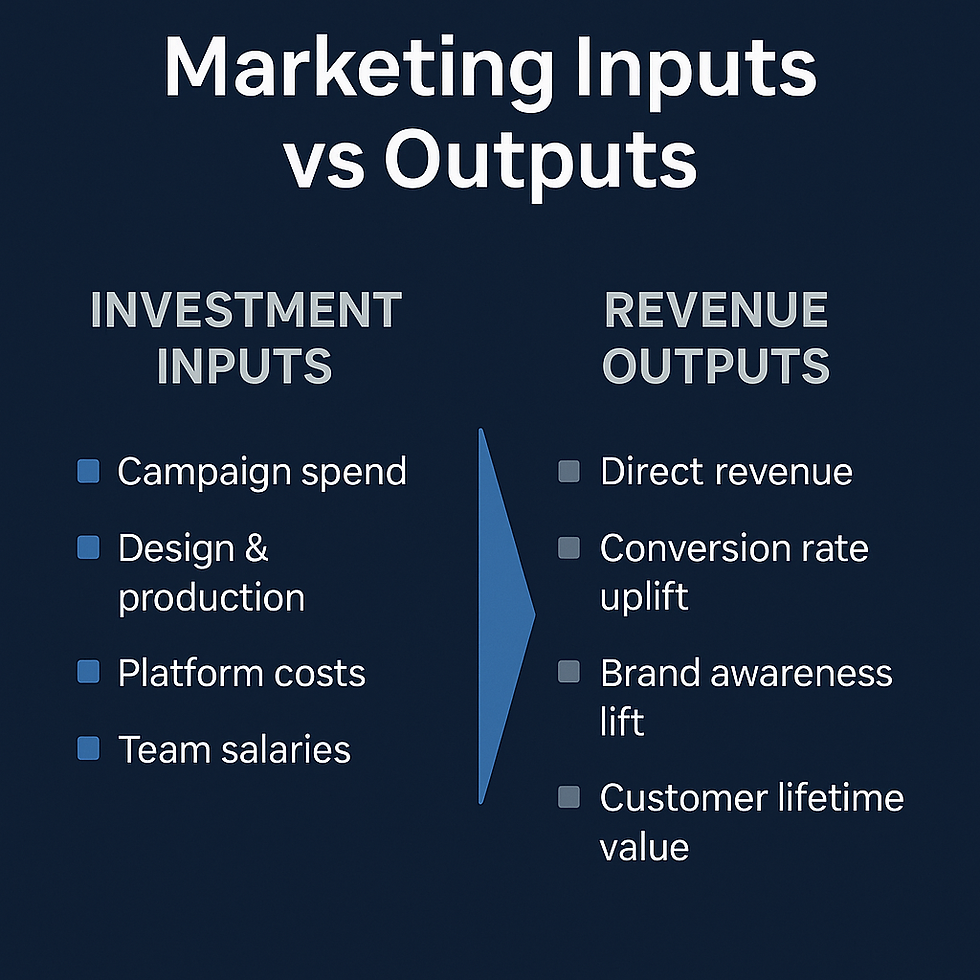The ROI Formula: How to Calculate Marketing ROI and Know What’s Actually Working
- Dolomites Consulting Team

- Mar 10
- 4 min read
One of the most common frustrations we hear from business owners and executives is simple:
“I have no idea if our marketing is actually driving revenue.”
And they’re not wrong.
Many marketing reports are full of engagement metrics like, impressions, clicks, video views, and likes, but leave out what really matters: profitability and revenue growth. The problem is that most businesses focus only on short-term performance or single-channel reporting, completely missing the bigger picture of how marketing actually works across multiple touchpoints, timelines, and platforms.
The solution? You need to measure marketing like an executive measures any business investment: with a complete ROI formula that includes both direct response and brand impact.
1️⃣ The Traditional Marketing ROI Formula (Direct Attribution)
Let’s start with the classic formula every executive knows:
Marketing ROI = (Revenue Attributed to Marketing – Marketing Investment) ÷ Marketing Investment
For example: If you invested $50,000 in marketing this quarter and generated $200,000 in sales directly attributed to that marketing:
ROI = ($200,000 – $50,000) ÷ $50,000 = 3 or 300% ROI
This calculation is straightforward when you’re running campaigns with clear tracking — digital ads tied directly to lead forms, e-commerce purchases, or sales pipelines that show clean attribution.
2️⃣ Why Most Companies Struggle to Truly Measure ROI
Even though the formula is simple, most companies fail to capture true ROI because:
Marketing and sales teams don’t have integrated tracking systems.
Leads are captured, but not properly attributed through the full sales pipeline.
Marketing reports stop at “leads generated” or “engagement rates” rather than closed revenue.
Many brand-building campaigns create impact that shows up later, but not in direct attribution models.
The result? Executives see disconnected dashboards and have no visibility into how marketing actually influences revenue over time.
3️⃣ The Reality: Brand Awareness Does Drive Revenue
Here’s where most executives and marketers make the critical mistake:
Not all marketing ROI is immediate.
Much of your marketing is building brand equity, trust, and recognition, setting the stage for future conversions.
Studies consistently show that it takes 7 to 10+ touchpoints before a buyer takes action (source: 2023 Gartner, Nielsen). Some research suggests that for higher-ticket or longer-consideration purchases, it can take 20–26 impressions to move a consumer from awareness to purchase.
While these touches may not directly lead to a sale today, they absolutely influence whether someone chooses you over competitors when they’re finally ready to buy.
💡Key Stat: 82% of consumers say they are more likely to purchase from a brand they recognize and trust. Source: Edelman Trust Barometer.
4️⃣ Incorporating Brand Awareness Into ROI Measurement
If you only measure direct conversions, you're missing the full value your marketing creates.
A more comprehensive ROI model includes both:

Direct Marketing ROI
Immediate conversions
Leads tied directly to campaigns
Clear cost per acquisition (CPA) or return on ad spend (ROAS)
Brand Lift ROI
Cumulative exposure and audience growth
Improved conversion rates over time due to increased familiarity
Higher lifetime customer value (LTV) from stronger brand loyalty
Competitive insulation by owning mindshare
In other words: Every impression, every piece of content, every exposure builds mental availability, keeping you top-of-mind until the customer is ready.

5️⃣ The Expanded ROI Formula for Executives
Here’s what a true ROI formula for today’s multi-channel marketing looks like:
Total Marketing ROI = (Direct Revenue + Estimated Brand Lift Revenue – Total Marketing Investment) ÷
Total Marketing Investment
The brand lift component can be modeled using:
Audience reach and frequency data
Historical conversion lift from retargeting audiences vs. cold audiences
Campaign-level lift studies (where available)
Revenue growth correlated with brand awareness campaigns over time
6️⃣ Tools That Help Connect These Dots
You don’t need complicated tools, you simply need connected tools that unify sales and marketing data.
Key platforms we implement for our clients include:
CRM (HubSpot, Salesforce, Zoho CRM): Lead attribution and sales pipeline visibility.
Google Analytics 4: Website behavior and conversion tracking.
Marketing Automation (ActiveCampaign, HubSpot Marketing Hub): Lifecycle tracking across channels.
Ad Platforms (Meta, Google Ads, YouTube): Impression, reach, and frequency metrics.
Attribution Dashboards: Custom-built reports that calculate both direct ROI and projected brand lift.
When your systems talk to each other, you finally get visibility that’s actionable.
7️⃣ Why Visibility Changes How You Spend Your Budget
When you properly track both direct and brand-building impact, you gain clarity that allows you to:
Cut waste on low-performing channels.
Double down on tactics that drive full-funnel value.
Forecast more confidently across quarters.
Justify budget requests with real business outcomes.
Align your marketing, sales, and executive teams around shared KPIs.
🔑 Key Executive Takeaways
✅ You cannot only measure marketing through short-term sales.
✅ Brand-building efforts contribute to conversion lift, often significantly.
✅ Frequency matters: 7–10+ exposures are typically required for a new customer to take action.
✅ Full-funnel attribution gives you the complete picture.
✅ Smart marketing teams model both short-term ROI and brand lift as part of executive reporting.
💭 Final Thoughts
If your marketing reports are still focused only on “leads” or “engagement,” you’re leaving your executive team blind to the full business impact.
True ROI measurement requires full-funnel visibility that includes both revenue now and revenue being built.
At Dolomites Consulting Group, we help companies build marketing ROI frameworks that connect every level of your funnel — from brand reach to closed sales — so you finally know what’s working, what’s wasting money, and how to scale smarter.




Comments